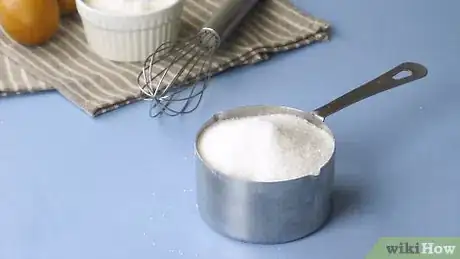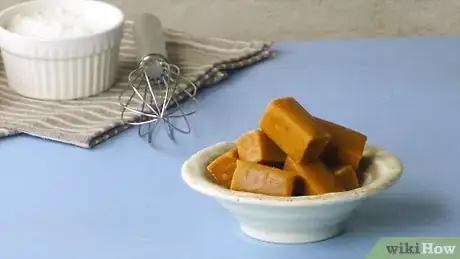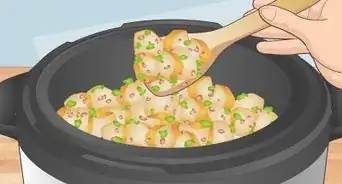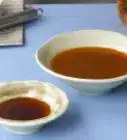This article was co-authored by Jessica Banh. Jessica Banh is a Pastry Chef and the Owner of Fancy Flavors in San Jose, California. With over 12 years of technical experience, Jessica has expertise in a wide variety of pastry techniques and has a focus on macarons. Her work has been featured in The SF Chronicle, The Mercury News, and Good Morning America. She received her training from The Professional Culinary Institute.
There are 11 references cited in this article, which can be found at the bottom of the page.
This article has been viewed 389,349 times.
Melting sugar breaks the bonds of granulated sugar so it can be recrystallized into different shapes by using molds or other tools. Melting sugar is also the first step in making caramels and candies. The melting temperature determines what can be made with the sugar.[1] The process isn't difficult, but it's important to monitor the sugar carefully so it doesn't burn. See Step 1 to find out how to start.
Ingredients
- 1 cup sugar
- 2 tablespoons water
Steps
Melting Sugar
-
1Measure out the sugar. Determine how much sugar you want to melt. Since sugar is so tricky to melt evenly without letting it burn, you shouldn't attempt to melt more than 2 cups at a time.[2] If you need more for your recipe, melt a second batch separately.
- Use white granular sugar, also known as table sugar.
- A good rule of thumb when melting sugar is that 2 cups of sugar will make enough melted sugar to make 1 cup of caramel.
-
2Place the sugar and cold water in a heavy-bottomed pot. A heavy-bottomed pot insures an even distribution of heat. A medium-sized saucepan is usually perfect to use for melting sugar. Aluminum or steel pots work best.
- Use half as much cold water by weight as the amount of sugar you are using.
- Make sure the pot is completely clean. If sediment is left in the pot, sugar crystals could form around it.
- A pot is a good option—it has a lot of surface area that will be hitting the sugar.
Advertisement -
3Place the pot on the stove over medium low heat.[3] Using low heat means the sugar will take awhile to melt, but don't be tempted to turn it up; sugar will quickly burn when cooked over higher heat. Using low heat gives you better control.
-
4Stir continuously until the sugar is dissolved. Stirring at the beginning of the process helps break up lumps and make sure that the sugar is heated evenly. It's best to use a wooden spoon. Keep stirring until the sugar mixture turns clear and begins to boil. At this step, different candies can be made based on the final temperature of the sugar.
- Use a pastry brush to wash any sugar off the edge of the pan back down in with the rest of the sugar.
- If crystals form on the edge of the pan, they can seed crystal formation in the entire mixture and the sugar will seize. Brushing the sides of the pot very carefully with warm water can prevent this.
Caramelizing Sugar
-
1Cook for 8 to 10 more minutes without stirring. Once the sugar has melted and starts to boil, let it cook until it caramelizes.[4]
- Stirring at this point could cause crystal formation, so don't stir any more from this point on.
- The pan may be gently swirled to even the cooking process.
- The resulting caramel color should be a slight golden brown that forms at the edge of the pan.
-
2Check the temperature of the sugar with a candy thermometer.
- If you want the sugar to stay in its liquid form, it is ready when it reaches 340 to 350 °F (171 to 177 °C). At this point the color will be a rich golden brown.
- Removing a small spoonful of the mixture and placing it on a white plate will show the caramel's true color.
Using Melted Sugar
-
1Look for the appropriate doneness. Different temperatures are desirable for different applications. When your sugar reaches the desired temperature for your particular recipe, it is done. Use it immediately.
- Thread stage: 223 to 233 °F (106 to 112 °C) A teaspoonful of sugar will form thin threads when dipped into and removed from cold water. It is good for candying fruits and nuts.[8]
- Soft-ball stage:[6] 235 to 240 °F (113 to 116 °C) A teaspoonful of sugar will ball when dipped in cold water; the ball immediately flattens when removed from the water. It is good for making fudges and fondants.
- Firm-ball stage:[7] 245 to 248 °F (118 to 120 °C) A teaspoonful of sugar will ball when dipped in cold water; the ball holds its shape when removed from the water but loses it when it reaches room temperature or pressed. It is good for making caramel candies.
- Hard-ball stage:[8] 250 to 266 °F (121 to 130 °C) A teaspoonful of sugar will ball when dipped in cold water; the ball squish slightly when pressed or will be hard and sticky when removed from the water. It is good for making divinity or marshmallows.
- Soft-crack stage:[9] 270 to 290 °F (132 to 143 °C) A teaspoonful of sugar will separate into pliable threads when dipped in cold water.
- Hard-crack stage:[10] 295 to 310 °F (146 to 154 °C) A teaspoonful of sugar will separate into brittle threads when dipped in cold water.
- Caramel stage:[11] 320 to 350 °F (160 to 177 °C) The sugar will brown in the pan and start to have a caramel smell.
-
2
-
3Make caramel. To make a creamy caramel sauce, cream and butter are added to the sugar after it has melted.[13] This mixture is then used as a delicious topping for ice cream, chocolate cake and other decadent treats.
-
4Make spun sugar. Spun sugar is made by cooking melted sugar until it reaches the hard ball stage, meaning it will harden once it cools to room temperature. It can be used to make amazing designs to decorate all types of desserts.[14]
-
5Make caramel candy. This buttery, flavorful candy is made by adding cream and butter to the melted sugar, then cooking the mixture until it reaches the hard ball stage. At this point, the caramel is poured into molds and left to harden at room temperature.[15]
Community Q&A
-
QuestionWhat is a simple way to do sugar art?
 Community AnswerDip a whisk into the melted sugar and spin on a baking parchment.
Community AnswerDip a whisk into the melted sugar and spin on a baking parchment. -
QuestionAt what temperature do you cook sugar and water so that it turns white when cooled?
 Community AnswerNone. It either cools to a clear color (ranging from glass to dark amber) or you start folding the caramel while it is hot. This is hard to do without special equipment like cooling tables and hooks.
Community AnswerNone. It either cools to a clear color (ranging from glass to dark amber) or you start folding the caramel while it is hot. This is hard to do without special equipment like cooling tables and hooks. -
QuestionWhy is my caramel too hard?
 Community AnswerIt could be that you cooked it too long then let it sit, or that there's not enough butter.
Community AnswerIt could be that you cooked it too long then let it sit, or that there's not enough butter.
Warnings
- Melted sugar is very hot and very sticky. It is very easy to give yourself a bad burn.⧼thumbs_response⧽
- Avoid wearing loose clothing or jewelry. These may snag and cause injury.⧼thumbs_response⧽
- Tie long hair back, it can: obscure vision, distract from work, or snag.⧼thumbs_response⧽
- Stay alert at all times to prevent injury and to avoid burning the sugar.⧼thumbs_response⧽
Things You'll Need
- Heavy-bottomed pot
- Burner/Stovetop
- Sugar
- Small brush
- Small cup of warm water
- Candy thermometer
- Cold water
References
- ↑ https://www.thespruceeats.com/making-candy-without-a-candy-thermometer-520309
- ↑ http://whatscookingamerica.net/Sauces_Condiments/CarmelizingSugar.htm
- ↑ https://www.thekitchn.com/technique-caram-6291
- ↑ https://food.ndtv.com/food-drinks/how-to-caramelize-sugar-simple-methods-to-make-delicious-caramel-at-home-1882860
- ↑ Knox, Gerald M, editor. Better Homes and Gardens New Cook Book. 10th ed., pp. 92-93, Better Homes and Gardens, 1989.
- ↑ https://www.exploratorium.edu/cooking/candy/sugar-stages.html
- ↑ https://www.exploratorium.edu/cooking/candy/sugar-stages.html
- ↑ https://www.exploratorium.edu/cooking/candy/sugar-stages.html
- ↑ https://www.exploratorium.edu/cooking/candy/sugar-stages.html
- ↑ https://www.exploratorium.edu/cooking/candy/sugar-stages.html
- ↑ https://www.exploratorium.edu/cooking/candy/sugar-stages.html
- ↑ https://www.allrecipes.com/recipe/20979/spanish-flan/
- ↑ https://www.fifteenspatulas.com/homemade-caramel-sauce/
- ↑ https://www.foodnetwork.com/recipes/spun-sugar-recipe-2107466
- ↑ https://www.thekitchn.com/how-to-make-soft-chewy-caramel-candies-cooking-lessons-from-the-kitchn-180832
- https://bakerbettie.com/how-to-caramelize-sugar/
About This Article
To melt sugar, start by measuring out no more than 2 cups of white, granulated sugar. Then, pour the sugar and half as much water into a medium-sized aluminum or steel saucepan, and place the pan over medium-low heat. Using a wooden spoon, stir the sugar and water continuously until the granules begin to dissolve and the mixtures starts to simmer. Once it is simmering, let the sugar cook for 8-10 minutes without stirring it. When the caramel is ready, it will be a golden-brown color, and the temperature will be around 340 to 350 °F. For tips on how to use your sugar once you've melted it, read on!




















































